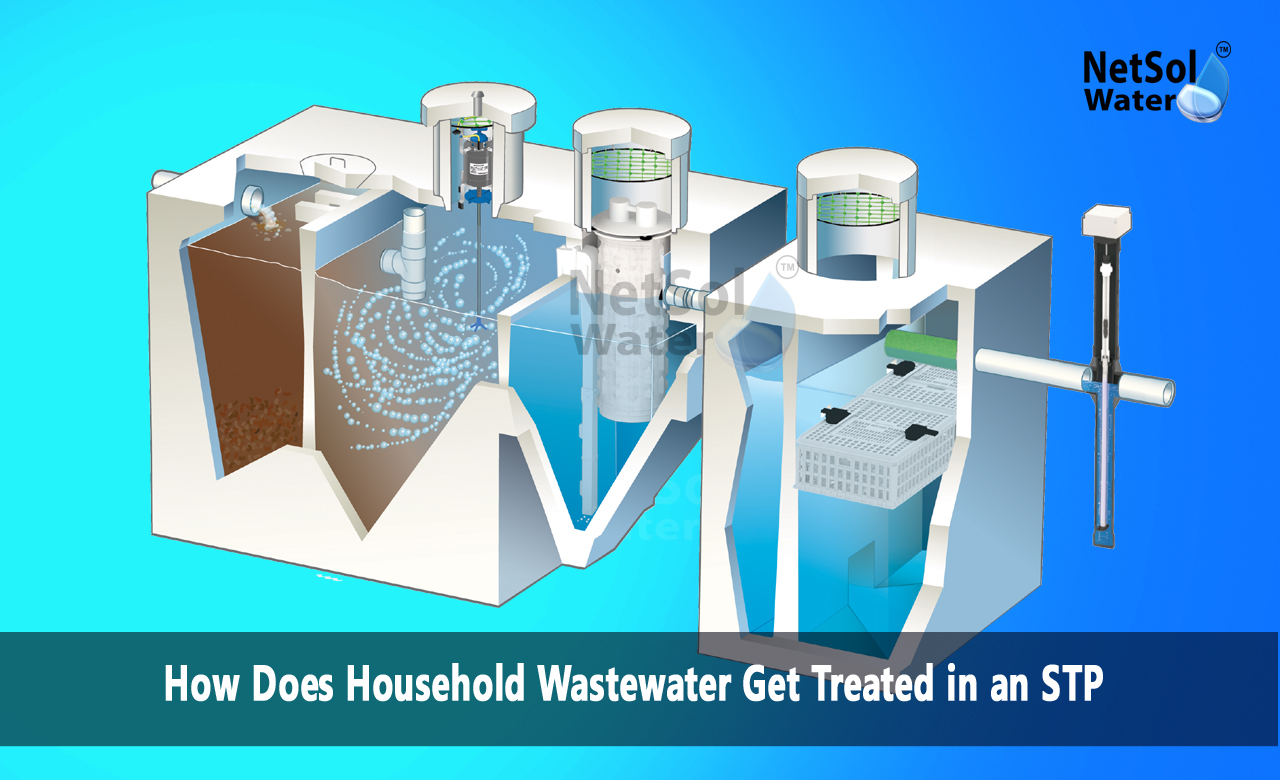How Does Household Wastewater Get Treated in an STP?
Household wastewater flows from kitchens bathrooms and laundry areas into sewer lines. It carries oils soaps food particles and human waste. Treating this water before it returns to the environment helps protect public health and conserve water resources. Netsol Water is a leading manufacturer of systems that handle this task. The company has manufacturer many Sewage Treatment Plant (STP) units worldwide. These make sure that water gets cleaned in stages. Each stage handles a specific set of pollutants. By doing so Netsol Water helps communities meet local regulations. The company also helps homeowners adopt reliable household wastewater treatment solutions.
We explore how does household wastewater get treated in an STP, We explain each step in a simple way. You will learn how grime settles out how microbes break down waste and how final polishing removes tiny particles. You will see how the treated water can return safely to rivers, parks or even homes for reuse.
Preliminary Treatment
Preliminary treatment plays a key role in protecting pumps and pipes from damage. It removes large solids and grit that can harm downstream equipment. Let us have a look at some processes in preliminary treatment.
Screening
Screens catch large objects such as rags plastics and paper. These items float or stay near the surface. A bar rack or mesh filter stops them from moving further. Operators must clear these screens by hand or by a rotating brush. Removing solids early keeps the rest of the plant running smoothly.
Grit Removal
Grit consists of sand small stones and eggshells. These dense particles settle quickly under gravity. In a grit chamber water slows down. Heavier grit drops to the bottom. A scraper or vacuum then collects the grit. This step prevents wear on pumps and valves.
Primary Sedimentation
Primary sedimentation handles finer solids that float or sink slowly. It reduces the organic load for later stages. Let us have a look at some elements of primary sedimentation.
Sedimentation Tanks
Large tanks allow water to flow slowly. Heavier particles sink to the tank floor. Grease and oils float to the surface. Sludge accumulates at the bottom while scum gathers on top. Operators then remove both layers for further processing. By the end of this stage most settleable solids have left the water.
Sludge Collection
A hopper shaped bottom helps collect sludge. Mechanical scrapers push the sludge toward a central point. Sludge then flows by gravity into holding tanks. These tanks buffer the material before final treatment.
Biological Treatment
Biological treatment uses organisms to break down dissolved and suspended organic matter. It forms the heart of household wastewater treatment. Let us have a look at some methods of biological treatment.
Aeration Basins
In aeration basins microorganisms feed on organic pollutants. Air injected by diffusers keeps them alive. Bacteria form flocs that trap particles. This process transforms waste into simpler compounds. The mixture of water and biomass moves to the next tank.
Secondary Clarifier
Here the biomass flocs settle. Clear water rises to the top. The settled biomass returns to the aeration basin to maintain a high concentration of microbes. Excess biomass moves to sludge processing. This cycle keeps the system stable.
Tertiary Treatment
Tertiary treatment polishes the water by removing remaining nutrients and fine particles. It ensures the effluent meets high quality standards. Let us have a look at some options in tertiary treatment.
Filtration
Water passes through sand or multimedia filters. These layers trap tiny particles. Filters require backwashing to remove trapped solids. Clean filters deliver water that looks clear.
Disinfection
Disinfection kills pathogens before release. Common methods use chlorine or ultraviolet light. Chlorine reaches all corners of the water. UV light inactivates microbes quickly. Both methods protect public health.
Sludge Processing
Sludge processing reduces volume and prepares solids for safe disposal or reuse. It handles the waste removed from earlier stages. Let us have a look at some steps in sludge processing.
Thickening
Thickening removes water from sludge. Gravity or flotation thickeners concentrate solids. This step cuts down the weight and size of the sludge.
Dewatering
Dewatering uses filter presses or centrifuges. These machines squeeze water out of the sludge. The result is a cake like material. This cake has low moisture and is easier to handle.
Disposal and Reuse
Dewatered sludge can go to landfills or land application. In some cases it faces further treatment for use as soil conditioner. Proper disposal prevents odour and health hazards.
Conclusion
A Sewage Treatment Plant(STP) makes household wastewater treatment safe and efficient. Netsol Water stands out as a leading manufacturer of reliable STPs. The company helps homeowners and communities meet water quality standards. If you need more details or wish to request a consultation reach out to Netsol Water today. Our experts will guide you to the right Sewage Treatment Plant(STP) for your home or facility.
Contact Netsol Water at:
Phone: +91-9650608473, Email: enquiry@netsolwater.com



